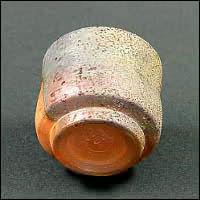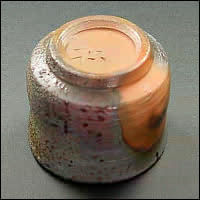|


Published by Yakimono.net January 2002
Bizen Piece from Korakuen Kiln
This is the first Bizen guinomi I ever bought. So plain and simple to my eyes now, yet since it holds such sentimental value I could never let it go. On top of that it holds a deep truth about what made Japan a rich cultural country and what will undoubtedly play a key role for her future as well -- the shokunin (artisan) spirit.
It must have been about fourteen years ago when I made my first visit to Imbe City (Bizen Country in Okayama Prefecture). I was really at a loss as to what shops to stroll into, so I think I went into them all! Zigzagging across the small streets, poking into every kamamoto and gallery I could find, by the end of the day I was exhausted! In one kamamoto I walked into, I was greeted with an unexpected hello; it was the Korakuen kiln and the man I encountered was Kimura Chojuroyukei. What a friendly man and so used to foreigners. Not like some of the other shops where I was greeted with a leery glance. It turns out that Kimura is a great reader of English and particularly Shakespeare; now that is a cultured man.
 The Korakuen kiln has a long history and one filled with shokunin craftsman that have made Japan strong. I especially like many of the wonderful saikumono that the kiln has produced throughout the ages. Coming from such a shokunin background I imagine Kimura didn't feel the need to become a ceramic artist. I don't say that in a negative sense at all. Indeed, as I mentioned, it is the shokunin skills that have created much of the beauty of Japanese culture. It wasn't the graduates of famous art schools but the boys who entered art worlds, trained, and became skilled artisans. That's the backbone of Japan. And that's why kilns such as Korakuen are important for Japan to support. If Japan loses the shokunin spirit then I find little hope for her future. Money comes and goes but the skills passed on from generation to generation remain and help to create beauty amidst the sordid details of modern life. The Korakuen kiln has a long history and one filled with shokunin craftsman that have made Japan strong. I especially like many of the wonderful saikumono that the kiln has produced throughout the ages. Coming from such a shokunin background I imagine Kimura didn't feel the need to become a ceramic artist. I don't say that in a negative sense at all. Indeed, as I mentioned, it is the shokunin skills that have created much of the beauty of Japanese culture. It wasn't the graduates of famous art schools but the boys who entered art worlds, trained, and became skilled artisans. That's the backbone of Japan. And that's why kilns such as Korakuen are important for Japan to support. If Japan loses the shokunin spirit then I find little hope for her future. Money comes and goes but the skills passed on from generation to generation remain and help to create beauty amidst the sordid details of modern life.
 This guinomi doesn't have the modern personality of many a modern Bizen work. It's quite ordinary in shape and has no splendid drinking lip or artistic foot. It was made without thought, most likely one of a few hundred made at one sitting, and fired with passion. The yohen colors on the piece are really delightful and the "window" on the front is a mini-landscape painting; so natural and uncontrived, it is a great tribute to the shokunin spirit. Of course the world of Japanese art is wide and works that reek of personality are most welcome too. Yet, a balance must be struck on the artistic seesaw. Today we see many young graduates of art schools with inflatable egos wanting to be somebody. If only they could see that by becoming nobody they in fact become everyman; and I'm sure many a great shokunin would drink to that. This guinomi doesn't have the modern personality of many a modern Bizen work. It's quite ordinary in shape and has no splendid drinking lip or artistic foot. It was made without thought, most likely one of a few hundred made at one sitting, and fired with passion. The yohen colors on the piece are really delightful and the "window" on the front is a mini-landscape painting; so natural and uncontrived, it is a great tribute to the shokunin spirit. Of course the world of Japanese art is wide and works that reek of personality are most welcome too. Yet, a balance must be struck on the artistic seesaw. Today we see many young graduates of art schools with inflatable egos wanting to be somebody. If only they could see that by becoming nobody they in fact become everyman; and I'm sure many a great shokunin would drink to that.
|